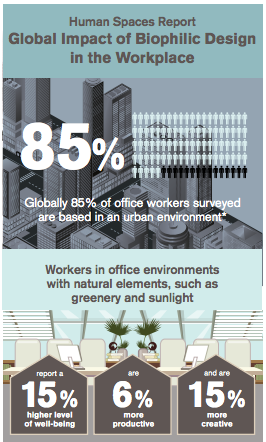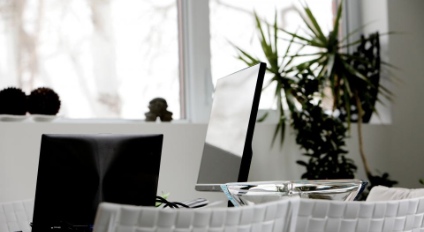What’s your take on ‘biophilic’ design?
While you’re unlikely to rattle off the finer points of the biophilia hypothesis to prospects during a tour, there is convincing research behind it that could help sell vacant space.
Biophilia describes our innate connection with nature and other forms of life, and our desire to be around it. Think large windows, natural scenery, plantlife, greenery, birdsong, and so on.
This website offers a useful introduction: “There are now many exemplary examples of buildings that seek to integrate natural features and qualities. We recognize the need for biophilic workplaces, for healing gardens and spaces in hospitals, and for homes and apartments that provide abundant daylight, natural ventilation, plants and greenery.”
 It’s easy to see how biophilic design fits into the workplace.
It’s easy to see how biophilic design fits into the workplace.
New research by organisational psychologist professor, Sir Cary Cooper, and modular flooring experts Interface reveals the extent to which workplace design can help keep staff happy and healthy – and also add weight to your sales pitch.
The Human Spaces Report studied 7,600 office workers in sixteen countries and examined what measures could be taken to increase employees happiness, creativity and productivity.
The top findings of the report include:
- Employees who work in environments with natural elements report a 15% higher level of well-being, are 6% more productive and 15% more creative.
- Globally, nearly half (47%) of office employees have no natural light and almost two thirds (58%) have no live plants in their workspace.
- A third (33%) of global respondents state that office design would affect their decision to join a company.
Serviced office suites with windows or eye-catching views have always held greater attraction and a natural advantage over interior units. Globally, nearly half (47%) of office employees have no natural light in their working environment, yet this was top of the ‘most wanted’ list of workspace elements with 44% of votes. This was followed by live indoor plants (20%) and a quiet working space (19%).
The research found that, despite leading city-dominated lives, workers have an inherent affinity to elements that reflect nature.
Commenting on the research findings, Professor Sir Cary Cooper, said: “As well as enabling organisations to make links between their physical spaces and the performance of their people, this study throws light on one of the defining challenges of modern life – our ability to cope with urbanisation and loss of connection with green spaces.”
How can operators integrate these findings into their workspace?
Chip DeGrace, Executive Creative Director at Interface, said: “What we can clearly identify is that there needs to be an ongoing evolution of the traditional office space, and it seems that as a global population, we are becoming ever more cognisant of our surroundings and how they impact us.
“We can see that working in environments with natural elements, such as greenery and sunlight, leads to a higher level of well-being and productivity, which is an important consideration for any business in terms of responsibility to its employees.”
While it may not be possible to knock windows into interior offices, this research suggests the potential for alternative techniques such as simulated sunlight. Avanta Serviced Office Group created this very effect with its ‘light room’ trial last year.
Introducing greenery or plantlife could also help trigger an emotional connection with prospects, while centres with outdoor spaces such as a roof terrace have a particular advantage.
And as for exterior suites or office space with large windows or attractive views, these stats just added significant weight to your sales pitch.
Thanks to StockSnap for the image


 Dr. Gleb Tsipursky – The Office Whisperer
Dr. Gleb Tsipursky – The Office Whisperer Nirit Cohen – WorkFutures
Nirit Cohen – WorkFutures Angela Howard – Culture Expert
Angela Howard – Culture Expert Drew Jones – Design & Innovation
Drew Jones – Design & Innovation Jonathan Price – CRE & Flex Expert
Jonathan Price – CRE & Flex Expert













